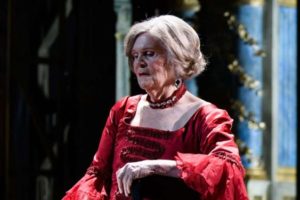

Anticipation turned dark a few months ago when the shocking news came that Met favorite Dmitri Hvorostovsky, the scheduled di Luna, had been diagnosed with a brain tumor. He immediately canceled all engagements for the next months and sought treatment in London. There was no announcement about the upcoming Met Trovatore run, but few probably expected that he would be well enough to appear. However, last month brought word that he would return to New York for the first three shows!
Doubters had been reassured lately by photos and videos on social media showing a happy-and-healthy-looking Hvorostovsky rehearsing and clowning around with friends and colleagues, so the atmosphere at the opera house before Friday’s performance was electric. When he did first appear from out of the shadows in the middle of the second scene, a huge roar went up from the packed audience and conductor Marco Armiliato stopped the music and joined in the jubilant applause himself. A clearly moved Hvorostovsky basked in the moment and momentarily broke character to acknowledge the love.
Toward eleven o’clock during the final bows, the cheering house rose en masse when the Siberian baritone loped onstage for his solo bow. The thundering roar continued for several minutes as he gestured his thanks to the audience. After the remainder of the cast and the conductor had appeared, groups bows ensued until the irrepressible Armiliato pushed Hvorostovsky out of the line for another solo bow and, in a stunning coup, several dozen white roses were flung onto the stage from the pit by members of the orchestra. Trovatore is not usually an opera that elicits tears, much less by its di Luna, but on Friday evening many in the theater, including an otherwise radiant Netrebko, were seen openly weeping.
Astonishingly no allowances needed to be made for return of Hvorostovky’s glamorously neurotic Count to the still-effective David McVicar production that he had premiered in 2009. If anything he sang better than ever, the voice big and beautiful. The long lines of “Il balen” were spun out with his signature elegance and enviable breath control but also with a minimum of the “huffing and puffing” that had occasionally crept in over the past few years. It was surely as good a performance of Trovatore as he has ever sung. But his return was not the only reason to cheer.

Even at 63 and after 27 years at the Met—where is there an Azucena anywhere today to compare to hers? Although the middle of the voice—never her strong suit—has gotten smaller and needs to be carefully managed, that indelible chest register and shining top (which would still be the envy of more than a few sopranos) continue ring out with power and bite. And over the years she has continued to refine her crazed gypsy—there was no trace of the routine as she once again recounted her mother’s immolation in a mesmerizing “Condotta ell’era in ceppi.” Another high point was an “Ai nostri monti” sung with an eloquent nostalgia that was quite affecting.
As her temperamental son, Korean tenor Yonghoon Lee sang boldly if blandly. This was my first in-house experience with Lee whose Manrico occasionally got lost on a big stage otherwise loaded with so much high-voltage star power. While he’s tall and handsome, his generic acting consisted mostly of pained looks toward the Family Circle and wide-open arm gestures. The bright, lean voice doesn’t have much individuality but he did deliver a sensitively shaded “Ah si, ben mio,” though he might work on his “fake” trill. Just one verse of a vigorous “Di quella pira” followed, capped by brutally loud, if exciting acuti (and an amusing grunt), but one wishes he hadn’t dropped so many measures of music to prepare for that climax.
As the much-coveted Leonora, Netrebko got off to a rocky start. Her rich soprano sounded thick and heavy in the rapturous recitative leading up to “Tacea la notte” and the sweeping aria itself was decidedly earthbound, riddled with pitch problems. A misjudged cadenza at its conclusion didn’t prevent the adoring audience from giving the piece a long, loud ovation. The cabaletta (both verses) was an improvement but a hoped-for unwritten high D-flat to conclude the trio didn’t materialize. Leonora’s wonderfully expansive lines in the convent scene failed to soar, and one went into intermission fearful about the demanding scena that dominates the second half.

She vividly differentiated the two verses of “Tu vedrai” to convey Leonora’s growing desperation to free her bandit-lover. The subsequent blazing duet with Hvorostovsky sizzled with barely repressed sensuality as she manipulated the smitten Count to realize her scheme—the duet’s usually hectic conclusion has rarely been so thrillingly imbued with wild-eyed triumph. Although Lee tended to bellow in response, Netrebko dominated the final scene with finely arching lines of spun gold as Leonora succumbed to her tragic sacrifice.
A number of times during this special evening one earnestly wished for a more imaginative and precise conductor than the indulgent Armiliato. While I know many singers are happy to see this busy routinier smiling back at them from the pit, on this occasion, particularly during the evening’s uneven first half, he was hard-pressed to keep his forces together. Numerous coordination problems with the chorus were particularly jarring. Things worked better in the often inspired third and fourth acts, but sadly one never felt that Armiliato had much to say about Verdi and Trovatore.
Hvorostovsky appears with this same cast just twice more; those who can’t catch them in the house are exhorted to attend next Saturday’s HD transmission. He returns in February for four more performances, but with a different Leonora and Manrico. Netrebko, Zajick and Lee are joined by Vitaliy Bilyy as di Luna for a pair later next month before Antonello Palombi spells Lee for the fall’s final fall Trovatore on October 17.
Photos by Marty Sohl/Metropolitan Opera; video via YouTube.
























Comments